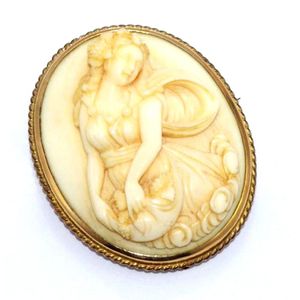Agate Cameo Brooch with Female Profile in Gold Mounting
agate cameo brooch, circa 1900, female profile carved in four strata, facing dexter, wearing a laurel wreath, mounted in 15ct gold, approximately 45 x 35 mm.
You must be a subscriber, and be logged in to view price and dealer details.
Subscribe Now to view actual auction price for this item
When you subscribe, you have the option of setting the currency in which to display prices to $Au, $US, $NZ or Stg.
This item has been sold, and the description, image and price are for reference purposes only.
- Agate - Agate is a type of semi-precious gemstone that is made up of silica dioxide, a mineral that is also found in quartz. It is known for its distinctive banded patterns, which are created as layers of silica are deposited in different colours including red, orange, yellow, green, blue, and purple. It is often used in jewellery, decorative objects, and other decorative items, and it is prized for its beauty and durability. Agate is found in many parts of the world, including Brazil, India, and the United States.
- Circa - A Latin term meaning 'about', often used in the antique trade to give an approximate date for the piece, usually considered to be five years on either side of the circa year. Thus, circa 1900 means the piece was made about 1900, probably between 1895 and 1905. The expression is sometimes abbreviated to c.1900.
- Laurel Leaf - The use of the laurel leaf as a decorative element can be traced back to ancient Greece and Rome, where it was closely associated with victory and honour. In these cultures, the laurel was a sacred tree that was dedicated to the god Apollo and was believed to have protective and healing properties.
In ancient Greece, the laurel wreath was awarded to victors in athletic competitions, such as the Olympic Games, as a symbol of their achievement. The wreath was also associated with academic achievement, and was often worn by scholars and poets. The Greeks also used the laurel leaf as a symbol of victory in war, and it was often depicted in artwork alongside images of triumphant warriors and heroes.
The Romans continued this tradition, and the laurel wreath became a symbol of the highest military honor, the triumph, awarded to victorious generals. The wreath was also used to crown emperors and other important officials, and was often depicted in Roman art and architecture as a symbol of power and authority.
The laurel leaf is still used as a symbol of achievement, success, and excellence, and is frequently used in logos, emblems, and other branding materials. Its association with victory and honour has made it a popular choice for awards, medals, and other forms of recognition.
This item has been included into following indexes:
Visually similar items

A shell cameo brooch, set in silver, depicting Beatrice Cenci. Length 5.5 cm
Sold by
in
for
You can display prices in $Au, $US, $NZ or Stg.

A large antique cameo and 9ct gold brooch, with a well carved image of Bacchus. Marked 9ct approx 29 cm high x 21 cm wide
Sold by
in
for
You can display prices in $Au, $US, $NZ or Stg.

Gilt metal cameo brooch / pendant
Sold by
in
for
You can display prices in $Au, $US, $NZ or Stg.

Victorian carved ivory brooch, in gilt metal surround
Sold by
in
for
You can display prices in $Au, $US, $NZ or Stg.
